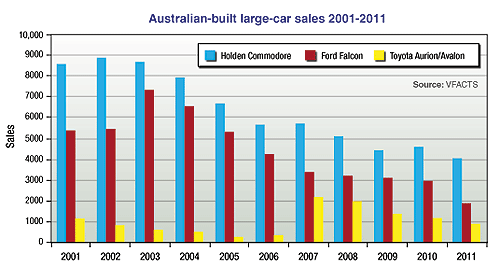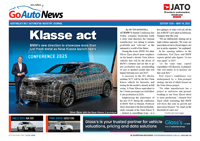News - Market InsightMarket Insight: Dice rolls for large car nicheDownward trend: Holden Commodore sales in 2011 were less than half of what they were only a decade ago. Dawn of new year brings future of Australian car manufacturing into question – again16 Jan 2012 By TERRY MARTIN TO HEAR Holden chairman and managing director Mike Devereux last week describe the local large-car market as “niche” underscores just how far Australian buyers have moved away from the segment underpinning this country’s car manufacturing industry. It was a big word for the boss of a company that, up until last year, had produced the biggest-selling vehicle in Australia for 15 years running, with Commodore’s fall to the Mazda3 marking the first time in memory that an imported car had ever topped the sales charts. Mr Devereux’s statement, and his point that Holden was more interested in building cars in mass-selling segments than niche, also demonstrates, for the first time, a resignation from the people running this industry that their future beyond this decade – or from around 2017, as the case may be – lies in vehicles other than large. A failure to make the shift will likely leave no option but closure – an outcome no-one in the industry and few in political circles want to see happen to what is a key manufacturing sector, a vital part of our economy and a massive source of employment. Holden has the Cruze small car program up and running and the potential to build other vehicles from the same platform, covering the losses stemming from its large cars and creating some cause for optimism.  Left: Holden chairman and managing director Mike Devereux. Below: Ford Falcon, Holden Cruze, Toyota Aurion and Toyota Camry. Left: Holden chairman and managing director Mike Devereux. Below: Ford Falcon, Holden Cruze, Toyota Aurion and Toyota Camry.While Holden’s large-car exports have shrunk, Commodore sales were down 11.6 per cent last year to just 40,617 units. Ten years ago, in 2002, Holden sold 88,478 Commodores. Unsurprisingly, the future of a uniquely Australian-designed and manufactured Commodore beyond the next 2014 VF Commodore is now uncertain, although talks in Detroit last week between GM top brass, federal manufacturing minister Kim Carr and South Australian premier Jay Weatherill were positive. For Ford, which abandoned its plan to build the Focus small car in Australia, the announcement last week of a further $103m guarantees nothing more than Falcon and Territory continuing until at least the end of 2016 – production that would have occurred regardless. At the highest levels, the Ford Motor Co has confirmed only that it will continue to sell large cars in Australia beyond that timeframe. But build? Ford has ruled out Australia as an export base for the company. It will move Falcon to a new global platform in around four years’ time, meaning the ute and Territory will also have to move, but there is no commitment to continued manufacturing here. Not yet, anyway. GoAuto believes a new mass-market model is on the table for discussion, which if given the go-ahead would keep Ford Australia’s Broadmeadows assembly plant in business. But there is no confirmation from Blue Oval management at this stage – just a twinkling in the eye. Falcon sales fell to their lowest point on record last year, down 36.5 per cent to just 18,741 new registrations. Back in 1996, when Ford was overall market leader – and the passenger car market leader for the 15th year in a row – the company racked up 77,835 Falcon sales in Australia. Falcon and Commodore together accounted for 25 per cent of the new-vehicle market in 1996. Last year, their combined strength was 5.9 per cent. Even with Camry and Cruze in the mix, locally manufactured cars made up only 14 per cent of last year’s new-vehicle market, with Falcon, Commodore and Aurion combined – a collective 68,273 units – accounting for 6.8 per cent. The total large-car market made up just 7.7 per cent of total industry sales, with the mainstream segment of cars under $70,000 down 21.7 per cent for the year. Although buoyed by the launch of its new-generation mid-sized Camry in recent weeks, and its hybrid and Aurion derivatives following this year, Toyota Australia has also encountered a severe erosion of its export business, increasing competition for contracts from other Toyota subsidiaries, potentially damaging industrial unrest, slow domestic Aurion sales – down 24.2 per cent last year, to 8915 units – and has had a tougher time of things with Camry, which was down 23.4 per cent last year to 19,169 units. There was, of course, a devastating Japanese natural disaster last year that restricted parts supply to the Australian factory, but it is worth noting that 2011 was the first time in a decade that local Camry sales had slipped below 20,000. As GoAuto has exclusively reported, Toyota Australia is still working on a plan to build another model at its Altona plant in Melbourne, which would greatly improve its long-term outlook as a manufacturer. As is the case with Ford and Holden, Toyota’s future relies on competitiveness in at least one mass-market segment and, above all, high-level government funding. Despite proactive talks and public displays of confidence from Senator Carr, the political will for continued taxpayer support – on both sides of politics – at current (eroded) levels, let alone an increase, is lukewarm. Without it, all indications from the local manufacturers and their parent companies are that Australia will have a very different automotive landscape – well before the turn of the decade.  Read more10th of January 2012  Ford invests in FalconFalcon, Territory future safe until 2016 as Ford and government invest $103 million10th of January 2012  GM deal set to save HoldenGovernments thrash out assistance package with GM in Detroit to secure local future9th of January 2012  Future Ford Oz exports unlikelyRegional boss says high production costs and currency make Australia uncompetitive9th of January 2012  Falcon decision delayedRegional boss insists that Ford Australia’s manufacturing future is not yet decided5th of December 2011  Market Insight: Ford’s tough EcoLPi routeSome signs of hope but hard yards still ahead for Ford’s Falcon and LPG8th of November 2011  Market Insight: Small is the new bigTrend-defying increase for the small-car segment in Australia3rd of October 2011  Market insight: Medium rare successMid-size cars set to slip past Aussie sixes as Toyota Camry and imports get fresh6th of September 2011  Market Insight: Toyota’s Camry hybrid shortfallToyota’s local Camry hybrid almost 30 per cent short of 10,000 target last year |
Click to shareMarket Insight articlesResearch Market Insight Motor industry news |
















Facebook Twitter Instagram